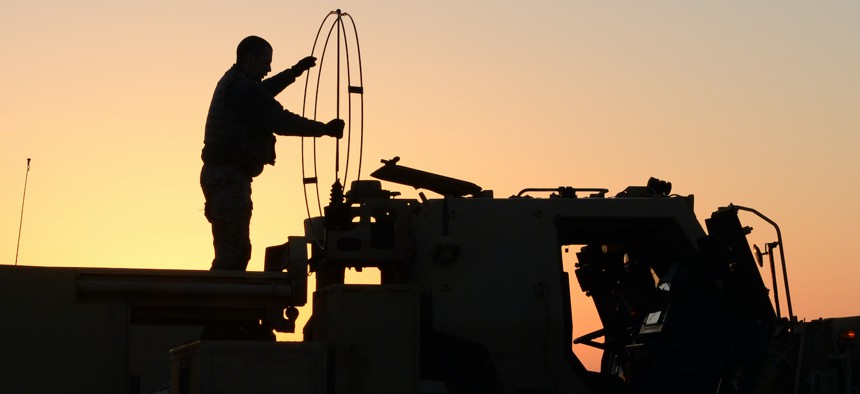
A U.S. Army soldier from 1st Battalion, 14th Field Artillery, 214th Fires Brigade, Fort Sill, Okla., unfolds an antenna on an M142 High Mobility Artillery Rocket Systems vehicle during a radio check, March 6, 2015. U.S. Air Force / Airman 1st Class Nathan Clark
Defense Business Brief: Lockheed, Microsoft in ‘landmark’ partnership; Army restocks rockets; USAF funds hypersonic tests; and more.
Lockheed Martin has struck a deal with Microsoft that will allow the defense giant to use the tech giant’s classified cloud. Lockheed is the first “non-government entity” allowed to “independently operate” within the Microsoft Azure Government Secret cloud.
The companies billed the partnership as a “landmark expansion of their strategic relationship to help power the next generation of technology for the Department of Defense.” Lockheed hopes access to the Microsoft cloud will allow it to move quicker on programs.
"Whenever you stand up a new classified program, it takes weeks to months to just get the IT in place to do it. And this will speed that whole process up immensely," Steve Walker, Lockheed’s chief technology officer told Reuters.
The two companies also agreed to collaborate on artificial intelligence, machine learning, modeling and simulation, and 5G edge computing.
Lockheed has been working more closely commercial tech firms since Jim Taiclet became the company’s CEO in June 2020. Taiclet, who came to Lockheed from the telecom industry, has forged partnerships with NVIDIA, Verizon, Qualcomm, and General Motors.
Last month, Taiclet said he had stood up an internal cell to create partnerships with mid-size defense, commercial, and space firms.
Lockheed’s hardly alone; most of the large prime defense contractors have been seeking closer relationships with commercial firms in an effort to gain access to their technology, which could in turn help move defense programs faster.
Speaking of Lockheed, the company kinda, sorta, has a new logo, which looks pretty much the same as the old logo. The font has slightly changed and the tails on its star logo are slightly shorter. Take a look here.
Welcome
You’ve reached the Defense Business Brief by Marcus Weisgerber. Programming note: We’re moving to Mondays after Thanksgiving! Look for the Defense Business Brief to appear in your inbox on Nov. 28. Send along your tips and feedback to mweisgerber@defenseone.com or @MarcusReports. Check out the Defense Business Brief archive here, and tell your friends to subscribe!
The U.S. Army awarded two deals collectively worth more than $500 million to replace Guided Multiple Launch Rocket Systems given to Ukraine. GMLRS (pronounced Gimmlers) are the rockets fired from HIMARS trucks, which Ukraine has famously used to repel occupying Russian forces.
The State Department will allow Switzerland to purchase Patriot missile interceptors. Recall: last year when Zurich chose the F-35 stealth fighter, it also said it would buy five Patriot batteries. The deal announced on Tuesday is for up to 72 PAC-3 missiles and other equipment. It could be worth up to $700 million, according to the Pentagon’s Defense Security Cooperation Agency, which oversees foreign arms sales.
Senators are growing impatient that the Navy has not told them how many amphibious ships it needs in the fleet. In a Nov. 14 letter to Navy Secretary Carlos Del Toro, Sens. Roger Wicker, R-Miss., and Tim Kaine, D-Va., want to know why the Navy has not provided details of a study that is supposed to determine the number of ships. In May. “We strongly urge you to provide the unredacted, unedited results of the study without further delay. If the study is still incomplete, please provide a reason as to why it is incomplete, whether you need any additional resources to complete the study, and when you expect it to be completed, as well as the results upon completion.” Read the letter here.
After nearly two and a half years in space, the U.S. Space Force X-37B space plane returned to Kennedy Space Center. The Boeing-made aircraft spent 908 days orbiting the globe, breaking its own record of 780 days. So what was it doing up there? “ Hosted experiments included a solar energy experiment designed by the Naval Research Lab, as well as a satellite designed and built by cadets at the U.S. Air Force Academy in partnership with the Air Force Research Laboratory,” according to a Nov. 12 Boeing statement.
The U.S. Air Force Research Laboratory awarded Stratolaunch a contract that funds the flight testing of the company’s Talon-A hypersonic test vehicle. Talon-A will be launched from the Stratolaunch’s massive, six-engine Roc aircraft. “Talon-A is a rocket-powered, autonomous testbed with the ability to fly a variety of hypersonic flight profiles while carrying customized payload experiments on board. The first Talon-A vehicle is an expendable configuration. The next generation of Talon-A vehicles will be capable of reusable hypersonic flight.”
The U.K. Defense Ministry selected Team Resolute, a three-company consortium, to build Royal Navy support ships. The $1.9 million contract “intends to create 1,200 U.K. shipyard jobs, hundreds of graduate and apprentice opportunities, and an expected 800 further jobs across the U.K. supply chain,” the MoD said.
Making Moves
Two-plus months after the White House said it would nominate Nickolas Guertin to be the Navy's top weapons buyer, this week, the Biden administration sent that nomination to the Senate. The position, which oversees billions in spending, has been without a Senate-confirmed leader for almost two years.




